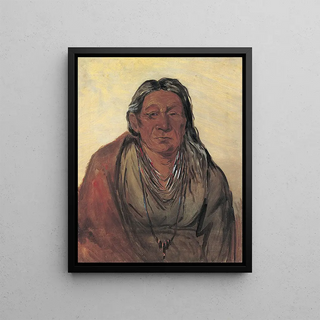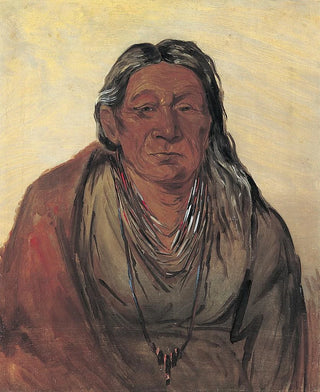Art print | Wahpeshsee Mother of the Chief - George Catlin Source: Reproduction | Wahpeshsee Mère du Chef - George Catlin


View from behind

Frame (optional)
The artwork "Wahpeshsee Mother of the Chief" by George Catlin offers a captivating window into 19th-century Native American culture. Through the artist's attentive gaze, this painting depicts not only a portrait but also a story, an identity, and a profound connection to the land. Catlin, as a passionate observer of Indigenous peoples of America, captured the essence of his subjects with rare sensitivity. The art print of this piece allows appreciation of the beauty and depth of this representation, while inviting viewers to explore the stories and traditions surrounding it.
Style and uniqueness of the work
Catlin's style is unique, blending realism and romanticism in an approach that transcends a simple portrait. In "Wahpeshsee Mother of the Chief," vibrant colors and meticulous details reveal a refined technique that highlights the dignity and strength of the depicted figure. The traditional clothing, adorned with symbolic motifs, as well as the serene expression of the mother of the chief, evoke a deep connection to her roots and heritage. This art print does not merely depict a person; it tells a collective story, that of a people and their struggles. Every brushstroke seems to resonate with the breath of ancestors, and the composition invites meditative contemplation of Native American life and culture.
The artist and his influence
George Catlin, painter and writer, is often regarded as one of the first artists to document Indigenous cultures with such dedication and passion. Traveling across the United States, he met numerous tribes, striving to capture their way of life before it was irreparably altered by colonial expansion. His work is much more than a simple collection of portraits; it is a valuable historical testimony that helps understand the sociopolitical issues of his time. Catlin was also a fervent advocate for the preservation of Indigenous cultures, campaigning for their recognition and respect. His influence endures, inspiring many contemporary artists to explore and celebrate

Matte finish

View from behind

Frame (optional)
The artwork "Wahpeshsee Mother of the Chief" by George Catlin offers a captivating window into 19th-century Native American culture. Through the artist's attentive gaze, this painting depicts not only a portrait but also a story, an identity, and a profound connection to the land. Catlin, as a passionate observer of Indigenous peoples of America, captured the essence of his subjects with rare sensitivity. The art print of this piece allows appreciation of the beauty and depth of this representation, while inviting viewers to explore the stories and traditions surrounding it.
Style and uniqueness of the work
Catlin's style is unique, blending realism and romanticism in an approach that transcends a simple portrait. In "Wahpeshsee Mother of the Chief," vibrant colors and meticulous details reveal a refined technique that highlights the dignity and strength of the depicted figure. The traditional clothing, adorned with symbolic motifs, as well as the serene expression of the mother of the chief, evoke a deep connection to her roots and heritage. This art print does not merely depict a person; it tells a collective story, that of a people and their struggles. Every brushstroke seems to resonate with the breath of ancestors, and the composition invites meditative contemplation of Native American life and culture.
The artist and his influence
George Catlin, painter and writer, is often regarded as one of the first artists to document Indigenous cultures with such dedication and passion. Traveling across the United States, he met numerous tribes, striving to capture their way of life before it was irreparably altered by colonial expansion. His work is much more than a simple collection of portraits; it is a valuable historical testimony that helps understand the sociopolitical issues of his time. Catlin was also a fervent advocate for the preservation of Indigenous cultures, campaigning for their recognition and respect. His influence endures, inspiring many contemporary artists to explore and celebrate






